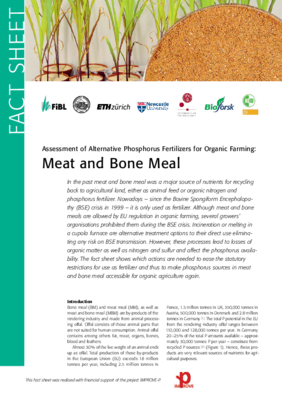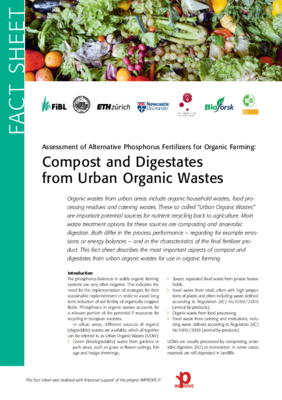Phosphorus is one essential element for plants, which can neither be produced synthetically nor substituted by any other element. Long term phosphorus management is one of the most important management challenges in organic farming, as high soluble P fertilizers derived from fossil sources are not allowed and do not contribute to the basic ideas of closing nutrient cycles.
Today, only small shares of the available meat and bone meal are used to produce fertilizers, as feed utilization is much more profitable than utilization as fertilizer. Nevertheless, meat and bone meals are especially well suited for fertilization of nitrogen demanding crops on acidic soils and low plant phosphorus availability. But for compliance with organic principles several aspects must be considered for the use of meat and bone meals such as their origin, the content of pollutants and their potential risks for animal and human health. Pasteurisation or sterilisation are the most effective ways to ensure that bone and meat meal fertilizers meet the organic farming principles while minimizing risk to consumers. Incineration or melting in a cupola furnace are alternative treatment options. However, these processes lead to losses of organic matter as well as nitrogen and sulfur and affect the phosphorus availability.
Organic household wastes, food processing residues and catering wastes are other important potential sources for nutrient recycling back to agriculture. Main treatment options for these sources are composting and anaerobic digestion. Both, compost and digestates, influence positively several soil properties like soil organic carbon, microbial activity and soil pH, and show relatively high direct plant phosphorus availability. While composts contain little amounts of easily soluble nitrogen, digestates have high N content, which has made them controversial fertilizers in organic agriculture. While the relationship between potentially toxic elements and nutrient concentration is more favorable with digestates, storage, handling during transport and field application are easier with composts.
Further information
FiBL-Contact
Links
- shop.fibl.org: Factsheet: Assessment of Alternative Phosphorus Fertilizers for Organic Farming: Compost and Digestates from Urban Organic Wastes
- shop.fibl.org: Factsheet: Assessment of Alternative Phosphorus Fertilizers for Organic Farming: Meat and Bone Meal
- improve-p.uni-hohenheim.de: Information on the IMPROVE-P project






